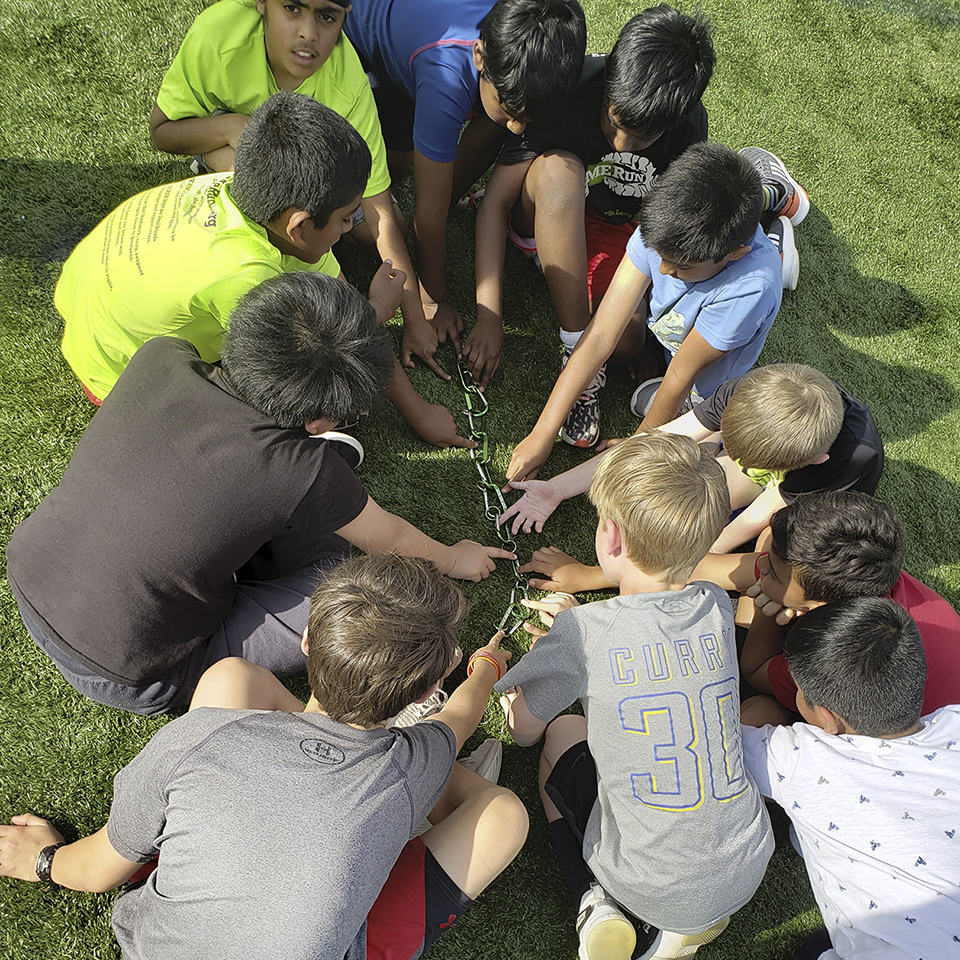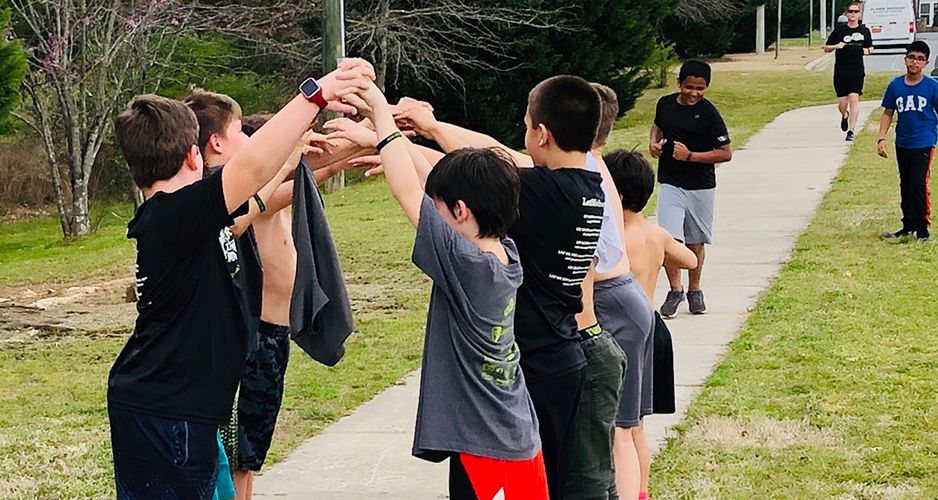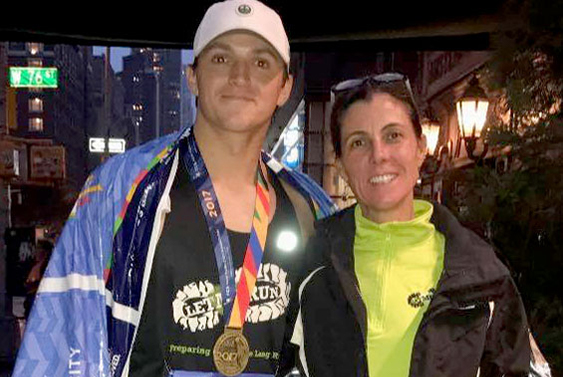
Finding Their Huddle
A boys running program inspires
multiple ways to exercise the heart
By Jen Tota McGivney | Photos Courtesy of Let Me Run
The toughest part of a Let Me Run practice can be the slowest part: the unity lap. But, with time and training, the boys in the group learn to slow their pace.
An unusual lesson for a boys running program? You bet. Let Me Run prides itself on doing things differently.
The unity lap kicks off each Let Me Run practice. This exercise takes a leave-no-man-behind strategy, with the fastest boy running at the slowest boy’s pace, creating one pack circling the track. Let Me Run encourages boys of all abilities to join, and it can be a challenge to teach some of them when it’s time to compete and when it’s time to encourage. Sometimes, the slowest child is new to running. Sometimes, he has Down Syndrome or Cystic Fibrosis. Sometimes, he’s in a wheelchair.
The unity lap isn’t about being quick, after all; it’s about being kind. After a few practices, the boys discover the fun of sticking together. This combination of athleticism and character development caught the attention of a former NFL player.
Leonard Wheeler was a safety in the 1990s, playing for the Bengals, Vikings and Panthers. Today he lives in Ballantyne and relishes his turn on the sidelines. He’s a motivational speaker, sought by corporations to engage their employees, and a personal coach, helping clients navigate professional and personal transitions. Some of his favorite mentees, however, are the Let Me Run participants. He’s not only on the group’s advisory board, but he’s often out running with the boys as well.
“Let Me Run is giving these boys their huddle,” Wheeler says. “They’re understanding how to go into life and create bonds and relationships with people who are different than they are. It’s having them create a high standard for themselves and teaching them to incorporate people into their lives.”
Big Hearts
Running is secondary to the bigger lessons taught by Let Me Run. This program for third to eighth graders uses running as a vehicle to develop the skills of compassion, team building, vulnerability and confidence. Even as the boys train together for a 5K, their sense of self and camaraderie are the top priorities, not their race times. Wheeler’s favorite moments of Let Me Run come from the biggest hearts.
“It’s the kids I see who wait for other kids to finish their runs, or the ones who will run back so they can run with someone through the finish line,” Wheeler says. “It’s the kids who encourage others with small words of validation by saying, ‘You did it! Yay!’ And you see that so much at Let Me Run.”
Just like Girls on the Run, its female counterpart, Let Me Run exploded because of enthusiastic parent and teacher demand. Let Me Run began in 2009 with 14 boys at Beverly Woods Elementary.
Soon, teams began forming in the Ballantyne area, too. The program reached Charlotte Latin in 2010, and today other area schools have teams, including Elon Park, Endhaven, Hawk Ridge and Ballantyne elementaries, as well as Community House Middle School.
Now, as Let Me Run celebrates its 10th year, the program has served more than 24,000 boys in 31 states.
Like most good ideas, this one started with a challenge. Ashley Armistead, mom to two sons, noticed that boys were consistently being sold short. Whether in the library or on the field, she saw too many people dismissing unkind behavior in boys — cutting in line, disrespecting property, even disrespecting each other — with a “boys will be boys” mentality.
“What I knew from spending so much time with my boys and other little guys is that it’s quite the opposite. I’d never met more fair, compassionate people than little boys,” Armistead says. “As time goes on, we see so many stats about when boys become disconnected and live into the narrow definition of masculinity, then they become depressed. Fighting stereotypes and learning to be your compassionate self can help alleviate that.”
Armistead delved into research about childhood development, mental health and gender roles. This research, combined with her degrees in nursing and sports science, as well as her experience as a Girls on the Run coach, sparked the idea for Let Me Run. She wanted to form a running club that would create a space for boys to be their true selves, encourage them to set high personal goals and support the goals of others, and help them return to the original meaning of competition: to strive together.


United by Age, Not Ability
Boys from all socioeconomic backgrounds participate in Let Me Run. Experienced runners who strive for faster times spark friendships with new runners excited to try their first 5K. Groups are united by age, not ability.
“Being an athlete is a mindset. Everyone is an athlete, but my athleticism may look different than yours,” Wheeler says. “It’s about understanding where your standard is and upping that standard one act at a time. I tell the boys, ‘Come back next week and go a little farther. Take one little step, that’s all you need.’”
One such athlete is Joseph Bark, a 12-year-old rising seventh grader at Weddington Middle School. In late June, he participated in Let Me Run Camp at Freedom Park with kids from across Charlotte. During one full morning for the campers, they ran their unity lap; listened to guest speakers from Running Works, a Charlotte running group for the homeless; ran up and down the greenway; and cleaned a stretch of Little Sugar Creek.
Being in Let Me Run has changed Bark physically. He says that the workouts mean sore muscles in the short term but increased strength in the long term. It’s changed him mentally, too. “(Let Me Run) puts higher standards in your brain,” he says. “When you reach one goal, then you know you can set higher goals. You can do more and more.”
That combination of physical and mental empowerment is one that Armistead and Wheeler hope will serve these boys the rest of their lives. They want to give them a place to discover that the strongest friendships are formed between people who are unafraid to become their true selves, who want the best for themselves and others. They want to give these boys their huddle — and the skills to build close huddles for the rest of their lives.
Motivating Kids to Exercise: 4 Tips
As a former NFL player, Leonard Wheeler knows the confidence-boosting power of physical activity. Here, he offers tips for parents about using exercise to encourage children.
- Work out with your kids.
Exercising with your children can create healthy habits and lifelong traditions. “My daughter is 22 years old,” Wheeler says, “and even now, when she comes home from college, she asks me when we’re going to work out together.”
- Make exercise fun.
If exercise is going to compete with video games, make it feel like a game, too. Instead of just a run, buy cones and create a racecourse. “Change the philosophy of working out. Don’t make workouts work, make workouts fun,” Wheeler suggests.
- Choose healthy foods that energize.
Sure, hot dogs and fast food make the kiddos smile, but Wheeler suggests instilling the discipline in kids to choose healthy foods that fuel their bodies and minds. Don’t forget that kids are watching your choices, too. Model healthy eating behaviors.
- Be generous with praise.
Offer constant reinforcement for kids’ positive choices. Whatever their level of athleticism, be quick to support their efforts and encourage their healthy habits. When kids see the confidence that others have in them, they develop more confidence in themselves.


